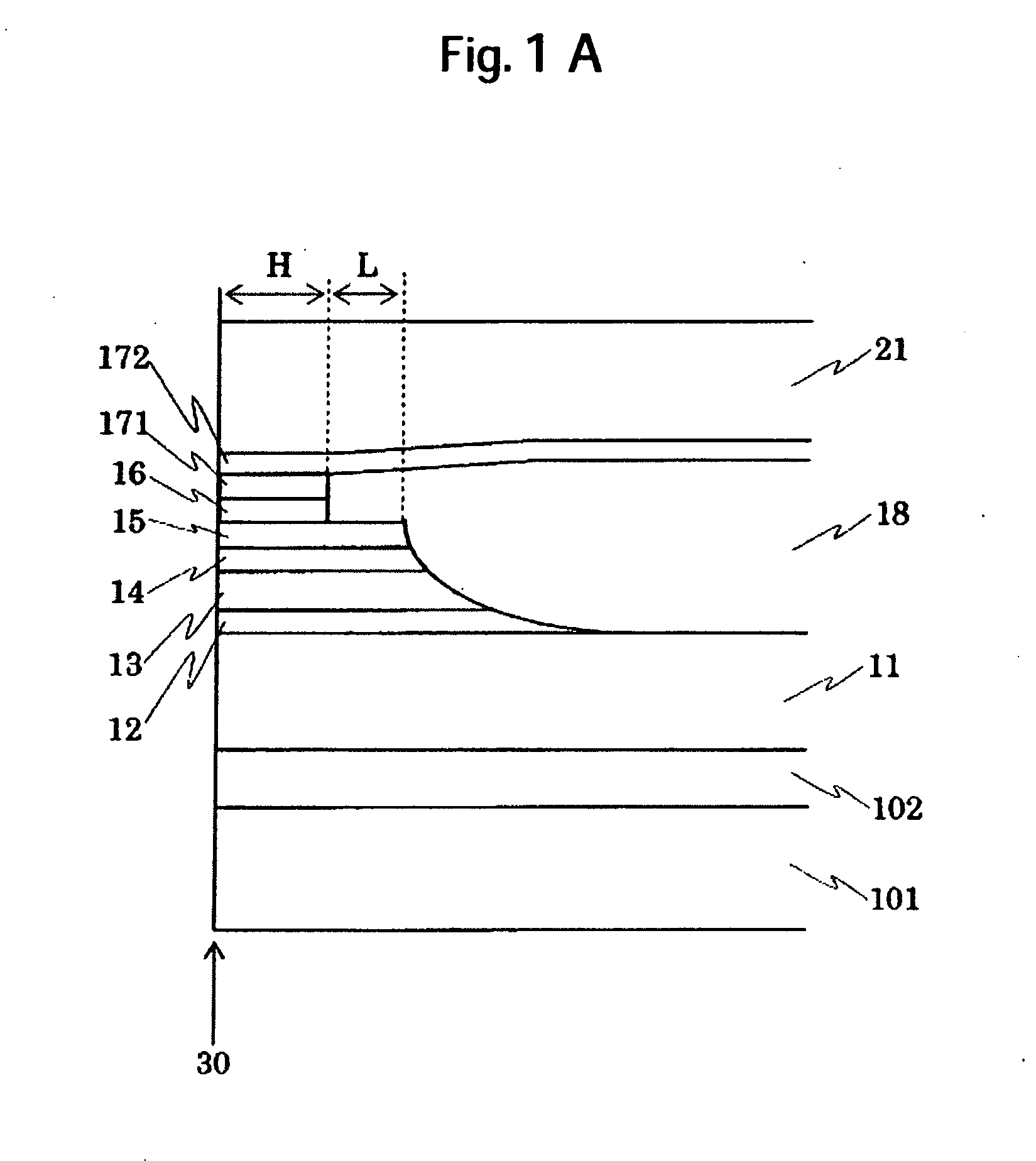Magnetoresistive head and a manufacturing method thereof
a technology of magnetoresistive head and manufacturing method, which is applied in the field of magnetoresistive head, can solve the problems of insufficient output, and easy steepening of height direction, and achieve the effect of maintaining electrostatic capacity to a small value and reducing the deterioration of dielectric breakdown voltag
- Summary
- Abstract
- Description
- Claims
- Application Information
AI Technical Summary
Benefits of technology
Problems solved by technology
Method used
Image
Examples
first embodiment
[0046]FIG. 1A shows a cross-sectional structure in the sensor height direction of a magnetic sensor of a magnetoresistive head of the present invention. For the reference, FIG. 1B shows structures in the track direction at the air bearing surface. Moreover, FIGS. 14(A)-(E) are schematic diagrams showing the processes to form the sensor height direction.
[0047] As shown in FIG. 14(A), a substrate 101 formed of a ceramic including alumina and titanium carbide is covered with an insulator film 102 such as alumina, the surface thereof is subjected to planarization with fine polishing. Thereafter, a lower magnetic shield layer 11 formed of Ni—Fe system alloy is formed. In this process, a film formed, for example, by the sputtering method, ion beam sputtering method or plating method is patterned into the predetermined shape, thereafter an insulator film of alumina is formed to the entire surface of the substrate, and the surface is subjected to the planarization with the chemical mechani...
second embodiment
[0069] In order to attain higher reproducing resolution, the distance between the lower magnetic shield layer 11 and the upper magnetic shield layer 21 must be shortened and thereby electrostatic capacity increases. A cross-sectional structure in the sensor height direction of the magnetic sensor of the magnetoresistive head of the present invention to solve the problem explained above is shown in FIG. 4.
[0070] In the first embodiment, the gradual taper at the edge in the sensor height direction of the magnetoresistive film stops at the lower gap layer 12 and the upper surface of the lower magnetic shield layer 11 is flat. Therefore, if a distance between the upper and lower magnetic shield layers is narrowed while the shape is maintained as it is, the electrostatic capacity increases. Accordingly, in this embodiment, increase in the electrostatic capacity is suppressed by widening the distance between the upper and lower magnetic shield layers at higher position along the sensor h...
third embodiment
[0071] In order to attain higher track density, side reading in the track direction must be reduced. As a means for realizing this purpose, a method has been proposed, in which the side shield is allocated in both sides of the magnetic sensor in the track direction. In this case, it is desirable to introduce the so-called in-stack biasing structure wherein a longitudinal biasing layer is stacked in the upper or lower side of the magnetoresistive film.
[0072]FIG. 5 shows a cross-sectional structure in the sensor height direction of the magnetic sensor of the magnetoresistive head of an embodiment of the present invention which is suitable for the in-stack biasing structure. In the basic in-stack biasing structure, a first pinning layer for pinning magnetization of the first ferromagnetic layer and a second pinning layer for pinning, in the track direction, magnetization of the longitudinal biasing layer 24 provided to applying the longitudinal biasing field to the second ferromagneti...
PUM
 Login to View More
Login to View More Abstract
Description
Claims
Application Information
 Login to View More
Login to View More - R&D
- Intellectual Property
- Life Sciences
- Materials
- Tech Scout
- Unparalleled Data Quality
- Higher Quality Content
- 60% Fewer Hallucinations
Browse by: Latest US Patents, China's latest patents, Technical Efficacy Thesaurus, Application Domain, Technology Topic, Popular Technical Reports.
© 2025 PatSnap. All rights reserved.Legal|Privacy policy|Modern Slavery Act Transparency Statement|Sitemap|About US| Contact US: help@patsnap.com



